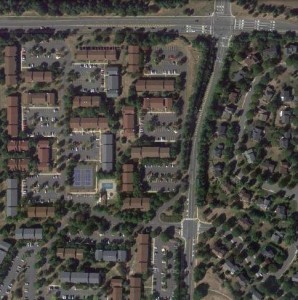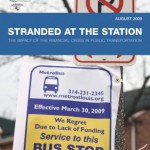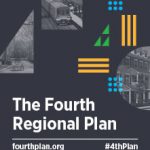New Jersey Future Blog
Density and Sprawl Are Not Mutually Exclusive
August 24th, 2011 by Tim Evans

Image source: Google Maps
Former New Jersey Future executive director Barbara Lawrence used to like to use the seemingly counterintuitive term “dense sprawl” to describe large garden-apartment and townhouse complexes which, while boasting high residential densities (i.e., a high number of housing units per acre), are physically cut off from employment and shopping areas and are accessible only by car. The term cleverly conveys that there is more to “sprawl” than just low population density. Low density is certainly one of the dysfunctions of New Jersey’s (and the nation’s) dominant development pattern since 1950, but it is not the only one. Separation of uses – keeping homes, stores, and workplaces each in their own segregated zones, distant from each other – and a lack of connectivity in the local street network (with lots of looping streets and cul-de-sacs and a lack of direct through-routes) also contrive to make it hard to get around without a car. These other two factors can force people into their cars for most daily activities even in neighborhoods with high housing density.
Conversely, a mix of land-use types (residential, employment, shopping, etc.) puts a variety of activities – not just a variety of buildings all housing the same activity – in close proximity, shrinking the distances among multiple types of destinations. And a well-connected, grid-like street network ensures that physical proximity actually translates into easy accessibility by offering multiple, direct routes among destinations. That is, it means short as-the-crow-flies distances are also short walking, biking, or driving distances that may not require a trip out onto the regional highway network. And of course, putting dense, mixed-use, well-connected neighborhoods near transit creates yet another option for getting to desired destinations that are farther away.
An article in last fall’s issue of Access, the magazine of the University of California Transportation Center, entitled “What Density Doesn’t Tell Us About Sprawl” cites the term “dense sprawl” to describe Los Angeles, by way of explaining how an urbanized area so closely associated with the term “sprawl” could, paradoxically, have such a high population density.
The article is more broadly concerned with disentangling the concepts of density and sprawl, using the L.A. region as the (counter)example:
But if we measure sprawl by population density, LA would not sprawl at all. In fact, it would be the least sprawling urbanized area in the country. How can Los Angeles be so dense and yet also exhibit so many characteristics associated with sprawl, including high levels of car travel (both in per capita and absolute terms) and low rates of walking, bicycling and transit ridership?
The article goes on to answer this question (with the “dense sprawl” quote):
… density by itself—the simple ratio of population to square mile—is not a very useful way to measure sprawl. What matters is the distribution of density, or how evenly or unevenly an area’s population is spread out across its geographic area. If we look at the density distribution in Los Angeles, we notice that its suburbs are much denser than those of other large U.S. cities, such as New York, San Francisco or Chicago. These high-density suburbs compensate for the comparatively low density of LA’s urban core, and, in so doing, increase the average density of the area as a whole …
The LA region’s combination of high, evenly distributed density puts it in an unfortunate position: it suffers from many of the problems that accompany high population density, including extreme traffic congestion and poor air quality; but lacks many of the benefits that typically accompany more traditional versions of dense urban areas, including fast and effective public transit and a core with vibrant street life. Los Angeles has, to borrow a term coined by urbanist William Fulton, “dense sprawl.”
The use of Los Angeles as a foil for the notion that density and sprawl are mutually exclusive was particularly gratifying, because New Jersey Future made some of these same points in our 2004 report Race to the Middle, in which we discussed the surprisingly murky relationship between density and traffic congestion. Sample quote:
Los Angeles, counterintuitively, anchors the most densely populated urbanized area in the country, yet it unsurprisingly (given its reputation) ranks first on all three congestion measures. It is thus necessary to look beyond density to explain congestion or the lack thereof.
The relationship is further muddied by the fact that the New York and Philadelphia urbanized areas, which together cover most of New Jersey and which both feature very dense core cities, do not appear near the top of the list of the urbanized areas with the worst traffic problems.
And later:
Yet Los Angeles should stand as a stern warning against developing simultaneously at high densities and in an automobile-dependent style … The best strategy for warding off congestion is to build at higher densities but with mixed uses, connected street networks, and a design paradigm that emphasizes walking and public transportation rather than the supremacy of the automobile – in short, to build in a style that resembles the older parts of New Jersey.
Also common to both pieces is an emphasis on the importance of measuring density at the correct geographic scale, as illustrated by the quote above from Access and by this excerpt from Race to the Middle:
New Jersey’s statewide population density is more than 1,100 persons per square mile, the highest of the 50 states … But what does 1,100 persons per square mile actually look like on the ground? … The reality is that 1,000 persons per square mile looks like low-density suburbia, or even – by the standards of the Northeast Corridor, at least – almost rural.
…
Reporting population density for a large geographic area can mask substantial internal variability … In computing national-level densities, the extraordinarily high densities of Tokyo and Calcutta are counterbalanced by the large areas of sparsely populated territory, with the result that the national statistic is not representative of the kinds of places that come to mind when one hears “density” in the same sentence with “Japan” or “India.” New Jersey’s statewide population density figure is likewise misleading.
The Access article goes on to suggest several innovative metrics for quantifying density – including a “density gradient index” that captures the important local-level variability in density – in ways that coincide with our intuitive perceptions. The article is worth a read in full (as is New Jersey Future’s report) and should serve as a caution for anyone who might be tempted to cite New Jersey’s status as the most densely-populated state in the country as evidence that New Jersey is too developed – or as evidence of anything conclusive at all, really.

















Well said. There is hope for these dense car-dependent areas. There’s usually enough space to put one commercial building (stores and/or offices) for every dozen residential buildings. Let’s talk to our city councilors and make it happen!